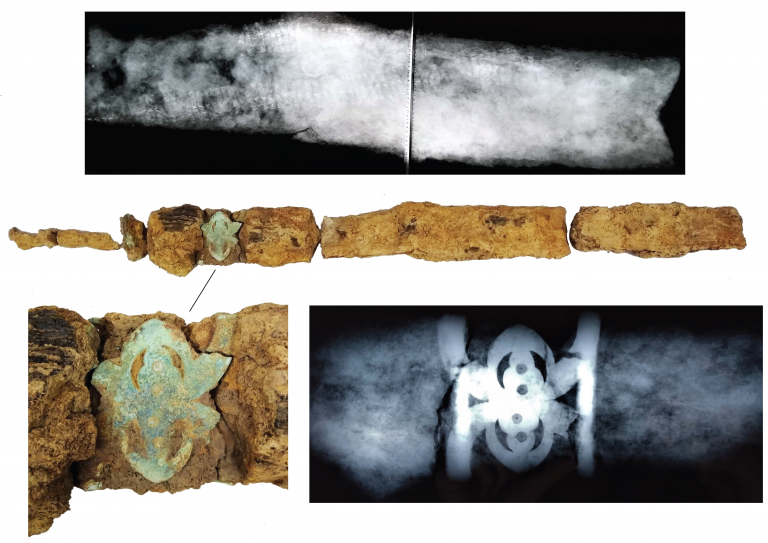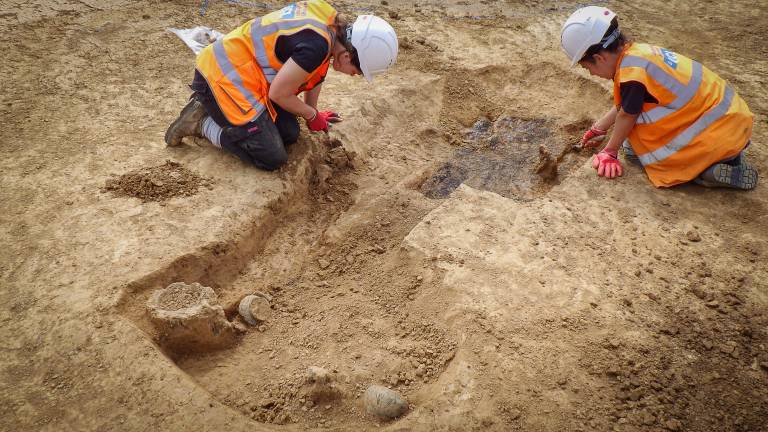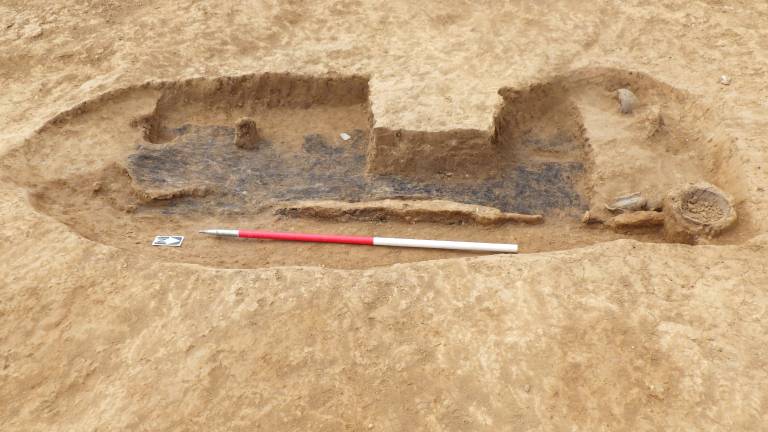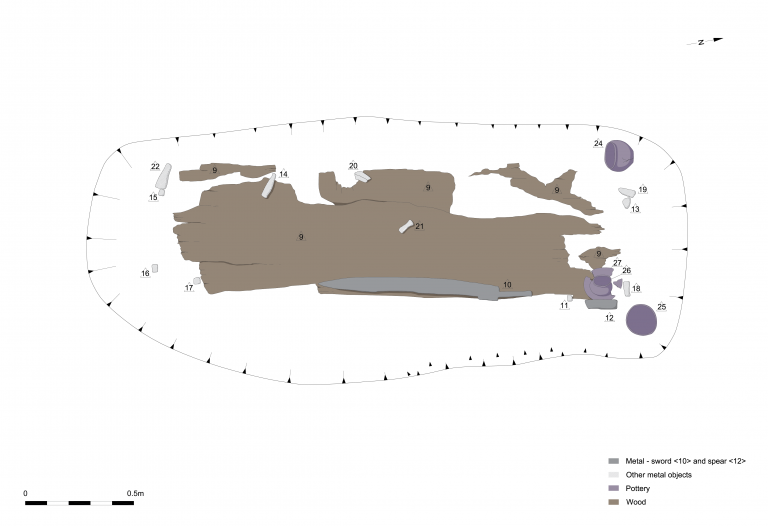The Walberton 'Warrior'
11 March 2020
One of the most exciting finds from our excavations in Walberton was a late Iron Age/ early Roman burial featuring a sword and a spear. These are sometimes called ‘warrior’ burials and are very rare in Sussex.

Over the summer of 2019 Archaeology South-East were contracted by Linden Homes to carry out archaeological investigations ahead of their housing development. We’ve posted a little on some of the finds from Walberton before (like the two horse burials), and you may have seen Walberton coverage in the newspapers! This post tells you more about the Walberton ‘warrior’ burial, more correctly known as a ‘burial with weapons’, dating to the late Iron Age/ early Roman period (1st century BC – AD 50), one of the most significant archaeological finds on the site. You can also hear lead excavator Teresa Vieira talking about the 'warrior' in our podcast episode.
Finding the burial
The grave cut itself was very hard to see as the fill of the grave was almost the same colour as the surrounding natural soil. Excavations started on this feature that archaeologists initially thought was a pit, but lead archaeologist Teresa Vieira soon realised that they were uncovering something very exciting! Slowly but surely the grave began to emerge!

The burial with weapons being excavated.
The grave contained a wooden ‘container’, or planks of wood – the dark patch in the picture below – on which the body would have lain as it was lowered into the ground. Although the skeleton was not preserved due to unfavourable soil conditions, archaeologists were incredibly excited to find an iron sword and spearhead within the grave! Based on the position of these objects, we think that the body was lain north to south, with the head to the north. Four ceramic vessels were placed outside of the container, but still within the grave. A 3D model has been made of the grave, which you can view here.

The grave almost fully exposed. Note the sword in the foreground, and the vessels to the right of the picture.

Schematic plan of the grave, with the wooden container, sword, spear, vessels and other metal objects highlighted.
Weaponry
The sword was carefully removed from site and taken to the conservation lab at the Collections Discovery Centre at Fishbourne Roman Palace, where it was x-rayed and is currently undergoing conservation.
Although still in the early stages of analysis, the conservation work has so far shown that the sword was held in a scabbard of organic material. The scabbard was strikingly decorated near the mouth with an intricate copper-alloy mount. Further research will reveal much more about this enigmatic design feature but for now, we do know that this would have been highly visible when the sword was worn – perhaps a bit like a badge of office? Broadly stylistically-similar examples have been found on other swords of Iron Age date, such as that found at Brisley Farm, near Ashford, Kent. The sword itself, although obviously very corroded, should be in good enough condition once conservation work is complete for experts in the field to identify exactly where it fits within the known typologies of Iron Age swords.

Even at this early stage, some interesting questions are arising from the preliminary work. What, for example are the dotted lines that are just visible on the x-ray? A current hypotheses is that these might be the remains of a studded garment that became melded with the mineralised organics of the scabbard. So, tangentially, we may be able to understand a little bit about how the body was dressed when buried from the weaponry buried with them.
Ceramics
The ceramic vessels placed outside of the grave cut are all jars, made from local clays. In domestic settings, jars of this type would generally be used in cooking, food preparation and storage. It is likely that they were placed in the grave as containers for funerary offerings, perhaps intended to provide sustenance for the deceased in the afterlife.

The forms of the vessels are very typical of the 1st century AD and some aspects of their fabric and technology hint that they may have been influenced by Roman potting techniques, suggesting a date close to or just after the Roman Conquest of AD 43. It is hoped that future scientific analysis may help to identify animal or vegetable fats that soaked into the vessel walls in order to provide insights into what they contained. It may also be possible to radiocarbon date tiny samples of these organic fats.
A Walberton Warrior?
There has been much discussion generally as to who the people buried in the ‘warrior’ tradition may have been in life. Where they really warriors, or just buried with the trappings of one? It is clear from the richness of the grave goods that they were important individuals, perhaps leaders or captains. Our example from Walberton is one of only two in Sussex, and only a handful in South England, so it will add valuable information to our understanding of these exciting burials.
To that end, there’s still so much to discover about our burial as we move through the post-excavation process. Even though we don’t have any skeletal remains, we may be able to tell more about the identity and social status of this individual based on other similar burials. By looking at the wooden container and the grave goods we want to find out in what ways the Walberton burial is unique, and/or how it fits in with other examples both in South England and further afield. We also want to investigate what taphonomic processes were responsible for the loss of the skeletal material, particularly as wood was preserved, which typically would not survive.
We hope to better understand the burial within its landscape. Are we looking at a sacred place dedicated to the veneration of the ancestors, as we previously found at Brisley Farm, or simply a grave, a place of the dead located near to where people were living?
One thing is for sure – this is an incredibly exciting and rare archaeological find, and our investigations are continuing!
 Close
Close

